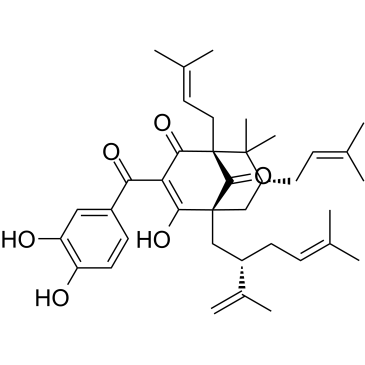| Description |
Garcinol, a polyisoprenylated benzophenone harvested from Garcinia indica, exerts anti-cholinesterase properties towards acetyl cholinesterase (AChE) and butyrylcholinesterase (BChE) with IC50s of 0.66 µM and 7.39 µM, respectively[1]. Garcinol also inhibits histone acetyltransferases (HATs, IC50= 7 μM) and p300/CPB-associated factor (PCAF, IC50 = 5 μM). Garcinol has anti-inflammatory and anti-cancer activity[2].
|
| Related Catalog |
|
| Target |
IC50: 0.66 µM (AChE); 7.39 µM (BChE)[1]; 7 μM (HATs); 5 µM (PCAF) [2]
|
| In Vitro |
Garcinol (10-50 µM; 24-72 hours) can inhibit the proliferation of two HNSCC cell lines tested (CAL27 and UMSCC1) in a time- and dose-dependent manner[3]. Garcinol (10-50 µM; 24-72 hours) induces apoptosis in HNSCC cells[3]. Garcinol (50 µM; 1-6 hours) suppresses phosphorylation and degradation of the constitutive IκBα in a time-dependent manner[3]. Cell Proliferation Assay[3] Cell Line: CAL27 and UMSCC1 cells Concentration: 10, 25, 50 µM Incubation Time: 24, 48, and 72 hours Result: Inhibited the proliferation of two HNSCC cell lines in a time- and dose-dependent manner. Apoptosis Analysis[3] Cell Line: CAL27 and UMSCC1 cells Concentration: 10, 25, 50 µM Incubation Time: 24, 48, and 72 hours Result: Induced apoptosis in HNSCC cells. Western Blot Analysis[3] Cell Line: CAL27 cells Concentration: 50 µM Incubation Time: 1, 2, 4, 6 hours Result: Suppressed phosphorylation and degradation of the constitutive IκBα in a time-dependent manner.
|
| In Vivo |
Garcinol (i.p.; 1 and 2 mg/kg; five times/week for 4 consecutive weeks) induces significant inhibition of tumor growth[3]. Animal Model: Five-week-old athymic nu/nu male mice bearing subcutaneous CAL27 tumors[3] Dosage: 1 and 2 mg/kg Administration: I.p.; five times/week for 4 consecutive weeks Result: Induced significant inhibition of tumor growth.
|
| References |
[1]. Lenta BN, et al. Leishmanicidal and cholinesterase inhibiting activities of phenolic compounds from Allanblackia monticola and Symphonia globulifera. Molecules. 2007 Jul 20;12(8):1548-57. [2]. Ciochina R, et al. Polycyclic polyprenylated acylphloroglucinols. Chem Rev. 2006 Sep;106(9):3963-86. [3]. Li F, et al. Garcinol, a polyisoprenylated benzophenone modulates multiple proinflammatory signalingcascades leading to the suppression of growth and survival of head and neck carcinoma. Cancer Prev Res (Phila). 2013 Aug;6(8):843-54.
|


